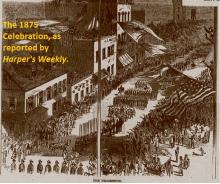You are here
Harper’s Weekly 6/12/1875, p. 476
The national magazine, Harper's Weekly, sent a reporter and an artist to Charlotte, NC, to document the centennial celebration of the Mecklenburg Declaration of Independence. The text of the article is given below, and you may also view a scan of the original page.
MECKLENBURG
The ceremonies of the Centennial anniversary of the Mecklenburg Declaration of Independence opened at noon, May 19, at Charlotte, North Carolina. The controversy respecting the true date of this Declaration has already been discussed at length in the Weekly, and we do not propose going into the vexed question now. Whatever the historian’s verdict may be, the people of North Carolina have settled the point for themselves, and held a grand and enthusiastic celebration of an event of which they are justly proud. According to the authorities following in this instance, a body of delegates met in the old court-house in Charlotte at noon on the 19th of May, 1775, and after a conference lasting all that day and night, adopted resolutions declaring themselves absolved from all allegiance to the British crown.
To celebrate this event great crowds of people from all parts of North Carolina and the adjoining States assembled at Charlotte on the 19th. The town was gayly decorated with flags, flowers, and evergreens. At noon the Stars and Stripes were hoisted on the Centennial flag-staff, 115 feet high, amidst enthusiastic cheering and the firing of cannon. The speeches on the occasion were eloquently patriotic. The Governor of the State, the Hon. CURTIS H. BROGDEN, paid a glowing and poetical tribute to the old flag, which was received with hearty cheers. In the evening many dwellings were illuminated, and the flag-staff was hung with lanterns on lines stretching to the four corners of the square on which it stood.
The next morning the town was thronged with visitors, the number present being estimated at over 40,000. The fair grounds, where the Declaration was read and the speeches were made, are about a mile from Independence Square, which is the centre of the town. In these grounds a large stand was erected for the orators of the day, the HON. JOHN KERR of North Carolina and Congressman BRIGHT, of Tennessee. After the speeches a banquet was served, and the people then returned to the town. The evening was occupied with patriotic speeches and displays of fire-works. Among the side diversions of the day were races and a grand cock-fight between North and South Carolina birds, which might better have been omitted from the programme.
Our illustrations of this celebration, from sketches made on the spot, tell their own story. We may mention, however, that the sketch of CORNWALLIS’S headquarters represents the rear of the building occupied by the Britishs general in 1780, the front having been modernized. It is said to be the only relic standing of the old town of a hundred years ago. At present Charlotte has between 5000 and 6000 inhabitants. It is pleasantly situated on Sugar Creek, about twenty miles from the South Carolina line, and has fine railroad facilities. Its water-power is utilized by several cotton factories, and the people are exhibiting an enterprise that will in time make Charlotte a centre of considerable trade and manufacture. The town is embowered in green trees, shrubbery, and flowers, and the residences are neat, and some very handsome, with pretty churches, etc. There are several institutions of learning. Queen’s College or Museum was established here long before the Revolution, but the museum building and the courthouse are both gone, and the site of the original Declaration is now commemorated by Independence Square.
